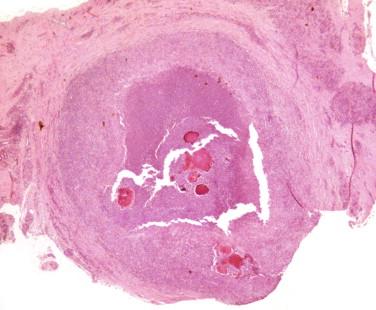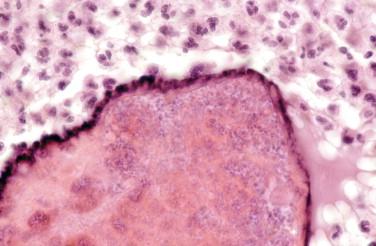Physical Address
304 North Cardinal St.
Dorchester Center, MA 02124
Botryomycosis, from the Greek botryo, meaning “grapes,” is a rare, chronic infection of the skin and viscera. This ancient name for the disease with the use of “mycosis” is actually inappropriate and misleading, because the infection is caused not by fungi but by bacteria. It involves the formation of granules and grains in tissues due to the presence of a large spectrum of nonfilamentous bacteria. It would therefore be more appropriate to refer to this disease as bacterial pseudomycosis or bacterial granules. The clinical lesions resemble those of mycetoma (eumycetoma and actinomycetoma) and actinomycosis, with the induction of pseudotumors containing draining sinuses and the presence of organism “grains” or “granules” in the lesions. The term sulfur granules may also be used, although this term is more classically associated with granules of actinomycosis caused by endogenous actinomycetes. The formation of granules in tissues remains a perplexing general mechanism, possibly reflecting the formation of bacterial biofilm in vivo as a mechanism of resistance against the inflammatory response of the host.
The usual causal agents are gram-positive Staphylococcus and Streptococcus and gram-negative species including members of the Enterobacteriaceae (E. coli, Proteus), Pseudomonas , anaerobes, and Actinobacillus.
Botryomycosis is found worldwide. Two forms, defined according to the site affected, have been identified: an integumentary form affecting the skin and subcutaneous tissues and a rarer visceral form.
The integumentary form is the most frequent. Immunodeficiencies, including HIV in particular, have been reported in some cases but most patients developing cutaneous botryomycosis have no immune system abnormality. Lesions take the form of localized, extensive plaques, or indurated subcutaneous nodules resembling epidermal cysts, or large swollen pseudotumors extending to deep subcutaneous tissues. All of these lesions are observed at the extremities, head, or inguinal region. A history of trauma or injury or the presence of a foreign body may be reported. Sinus tracts may be observed in lesions and pseudotumors persisting for several weeks or months, with discharge of a seropurulent exudate that may contain small granules visible to the naked eye. These granules are generally spherical, 0.2 to 1.5 mm in diameter ( Figure 15-1 ), and are usually soft and white or yellow when observed under the dissecting microscope ( Figure 15-2 ). Extension to the subcutaneous tissues and adjacent skeletal muscle and bone may be observed, together with fibrosis, resulting in tumefaction of the affected area.


The visceral form is rare. Most cases have been reported in immunocompetent patients, but a few cases have been described in patients with diabetes mellitus, neutrophil deficiency, cystic fibrosis, and AIDS. It generally affects the lung, liver, kidney, brain, heart, and prostate, resulting in chronic lesions and sequelae. Visceral involvement is not associated with skin infection. Lung involvement, referred to as pulmonary botryomycosis, is the most frequent type and may be primary or secondary following hematogenous dissemination. Several forms have been observed: an endobronchial form complicating old lesions of tuberculosis or bronchiectasis, tumor-like lesions, and lobular or diffuse pneumonia, frequently affecting the right lower lobe. Pulmonary botryomycosis may mimic tuberculosis, actinomycosis, or cancer. Atelectasis or nodules or foci of consolidation may be observed on x-ray. Chest wall involvement should be systematically suspected and assessed.
Other visceral sites have been reported in patients with underlying conditions, such as diabetes mellitus, extensive follicular mucinosis, AIDS, and cancer. The most frequently involved sites, after the lung, include the cervicofacial region, in which the infection may be associated with osteomyelitis of the mandible, the oral cavity (including tongue and jaw bone abscesses), the sinonasal tract, the lymph nodes, the liver and digestive tract wall (colon, rectum), the kidney (in which the infection may mimic cell carcinoma), the brain, the heart (often with grapelike botryomycotic vegetations), and the prostate gland.
Become a Clinical Tree membership for Full access and enjoy Unlimited articles
If you are a member. Log in here